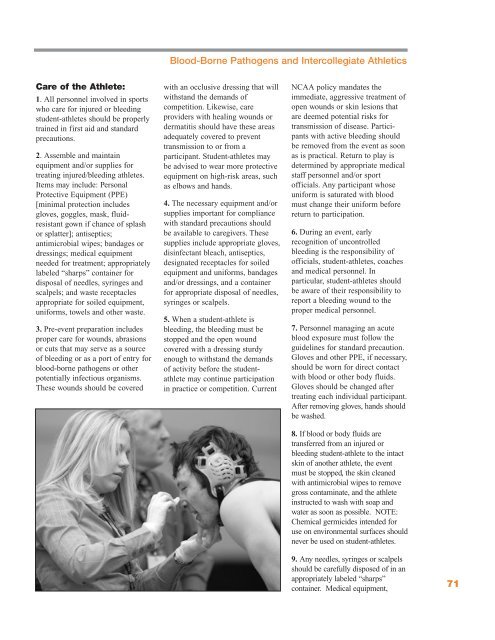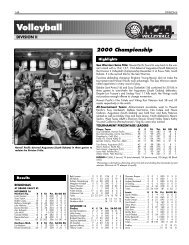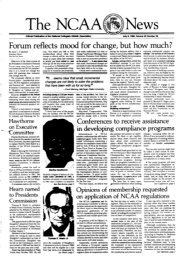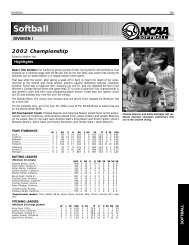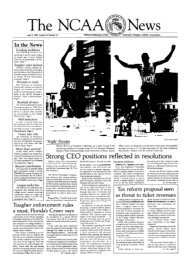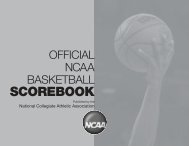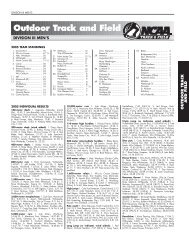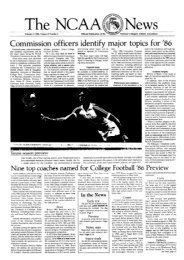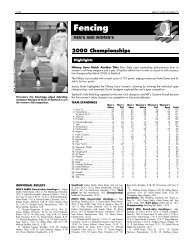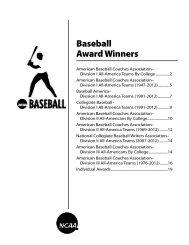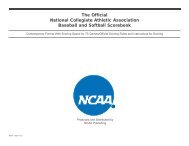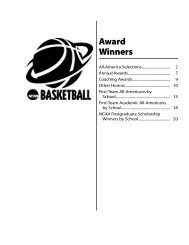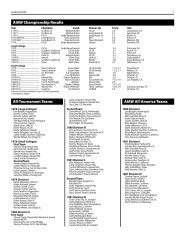Sports Medicine Handbook - NCAA
Sports Medicine Handbook - NCAA
Sports Medicine Handbook - NCAA
Create successful ePaper yourself
Turn your PDF publications into a flip-book with our unique Google optimized e-Paper software.
Care of the Athlete:<br />
1. All personnel involved in sports<br />
who care for injured or bleeding<br />
student-athletes should be properly<br />
trained in first aid and standard<br />
precautions.<br />
2. Assemble and maintain<br />
equipment and/or supplies for<br />
treating injured/bleeding athletes.<br />
Items may include: Personal<br />
Protective Equipment (PPE)<br />
[minimal protection includes<br />
gloves, goggles, mask, fluidresistant<br />
gown if chance of splash<br />
or splatter]; antiseptics;<br />
antimicrobial wipes; bandages or<br />
dressings; medical equipment<br />
needed for treatment; appropriately<br />
labeled “sharps” container for<br />
disposal of needles, syringes and<br />
scalpels; and waste receptacles<br />
appropriate for soiled equipment,<br />
uniforms, towels and other waste.<br />
3. Pre-event preparation includes<br />
proper care for wounds, abra sions<br />
or cuts that may serve as a source<br />
of bleeding or as a port of entry for<br />
blood-borne pathogens or other<br />
potentially infectious organisms.<br />
These wounds should be covered<br />
Blood-Borne Pathogens and Intercollegiate Athletics<br />
with an occlusive dressing that will<br />
withstand the demands of<br />
competition. Likewise, care<br />
providers with healing wounds or<br />
dermatitis should have these areas<br />
adequately covered to prevent<br />
transmission to or from a<br />
participant. Student-athletes may<br />
be advised to wear more protective<br />
equipment on high-risk areas, such<br />
as elbows and hands.<br />
4. The necessary equipment and/or<br />
supplies important for compliance<br />
with standard precautions should<br />
be available to caregivers. These<br />
supplies include appropriate gloves,<br />
disinfectant bleach, antiseptics,<br />
designated receptacles for soiled<br />
equipment and uniforms, bandages<br />
and/or dressings, and a container<br />
for appropriate disposal of needles,<br />
syringes or scalpels.<br />
5. When a student-athlete is<br />
bleeding, the bleeding must be<br />
stopped and the open wound<br />
covered with a dressing sturdy<br />
enough to withstand the demands<br />
of activity before the studentathlete<br />
may continue participation<br />
in practice or competition. Current<br />
<strong>NCAA</strong> policy mandates the<br />
immediate, aggressive treatment of<br />
open wounds or skin lesions that<br />
are deemed potential risks for<br />
transmission of disease. Participants<br />
with active bleeding should<br />
be removed from the event as soon<br />
as is practical. Return to play is<br />
determined by appropriate medical<br />
staff personnel and/or sport<br />
officials. Any participant whose<br />
uniform is saturated with blood<br />
must change their uniform before<br />
return to participation.<br />
6. During an event, early<br />
recognition of uncontrolled<br />
bleeding is the responsibility of<br />
officials, student-athletes, coaches<br />
and medical personnel. In<br />
particular, student-athletes should<br />
be aware of their responsibility to<br />
report a bleeding wound to the<br />
proper medical personnel.<br />
7. Personnel managing an acute<br />
blood exposure must follow the<br />
guidelines for standard precaution.<br />
Gloves and other PPE, if necessary,<br />
should be worn for direct contact<br />
with blood or other body fluids.<br />
Gloves should be changed after<br />
treating each individual participant.<br />
After removing gloves, hands should<br />
be washed.<br />
8. If blood or body fluids are<br />
transferred from an injured or<br />
bleeding student-athlete to the intact<br />
skin of another athlete, the event<br />
must be stopped, the skin cleaned<br />
with antimicrobial wipes to remove<br />
gross contaminate, and the athlete<br />
instructed to wash with soap and<br />
water as soon as possible. NOTE:<br />
Chemical germicides intended for<br />
use on environmental surfaces should<br />
never be used on student-athletes.<br />
9. Any needles, syringes or scalpels<br />
should be carefully disposed of in an<br />
appropriately labeled “sharps”<br />
container. Medical equipment,<br />
71


